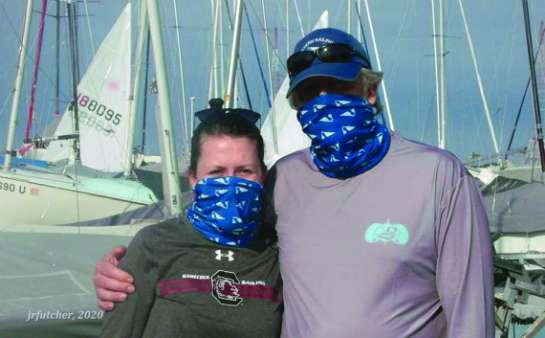Safety a Top Concern at the Boat Park and on the Water
Major regional, national, and international racing championships continue to be cancelled—and that all makes sense. If competitors can’t safely get themselves or their boats to the regatta due to Covid-19, it’s certainly not right to crown a champion. But dinghy racers are exploring ways to not only get out sailing, but now also to incorporate some lower-profile racing events. Much of our racing activity this year will be at the local fleet level, and it’s a great opportunity to get family members sucked into the joy of small-boat racing, too.

It’s critical to maintain safety practices and social distancing. Many clubs are proactively creating new infrastructure to support safe sailing. At Severn Sailing Association (SSA), for example, in addition to the wearing of face masks while on the property being mandatory, the club has added outdoor hand-wash stations operated by foot pedal to enable good hygiene. And new dispensers on the hoists give everyone who’s operating those up and down buttons the opportunity to use hand sanitizer before and after they operate the lifts.
Best practices at regattas are evolving, too. For the Snipe Colonial Cup, slated for the last weekend in June at SSA, the Notice of Race and Sailing Instructions included a number of new practices. Much of this has been guided by regatta co-chair, Kristin Mullins, who in her day job is assistant professor of pathology at the University of Maryland School of Medicine where she does research on tropical infectious diseases… and now Covid-19. Her Ph.D. is in emerging infectious diseases, so she’s a great source of knowledge as the Snipe fleet gets racing again.
The regatta will look different from past editions, where hordes of Snipe sailors from around the country descended on SSA to enjoy great racing on the water and an outstanding social scene back on shore.
“For the Colonial Cup we are going to try to do everything we can to socialize distantly. I am excited that we are able to get everyone back out on the water, but we really want to make sure we minimize risks and provide a comfortable environment for all that want to participate,” Mullins said.
“We plan to assign spaces for boat set up to ensure that boats are six feet apart on the lot, stagger launches so that the hoists do not get backed up with lots of people standing around a small area, and we will have Zoom meetings for the skipper’s meetings, any protests, and a regatta debrief.”
This year—no social events. Registration is limited to 20 boats. There is a waitlist beyond that. That’s to enable enough space between boats in the boat park and at the hoists. Mullins stresses other practices individuals can emphasize to help keep themselves—and others—safe.
“As for places to be careful, I agree bathrooms would be a good area to avoid, and that goes for any indoor areas of your club or sailing center. My husband and I are planning to come dressed for sailing rather than changing on site,” she suggested. “Hand sanitizer and masks are great to have with you. I am also bringing along disinfectant wipes to wipe down any high-touch surfaces, such as the hoist buttons or door handles.”
And how about on the boat, with your crew? Here in Maryland, as of this writing, you’re allowed to go out boating with folks who aren’t in your immediate household—but are supposed to be following social distancing protocol. So that means six feet apart… well that’s a little tough on many dinghies!
Many people are finding skipper-crew combinations within their own household. For example, Mullins is sailing with her husband. For others, it can mean a heart-to-heart conversation among skipper and crew about what risks each crew member has taken and what each crew member’s level of comfort is. Some people are all in on indoor dining and restaurants; others aren’t. Both are okay—and it’s important to talk about it. Depending on everyone’s level of comfort, it can mean a long, hot day with masks on (buffs aren’t as effective as woven cotton masks), as teammates spend about six hours on a race day in very close proximity—or accepting a greater level of risk.
Whether this situation is the “new normal” until a vaccine is developed, the virus ramps up with a vengeance, or simmers down over the summer—well, we won’t know until we can look back and actually describe it. We’re all eager to get out sailing and racing. Let’s be sure to do it smartly and safely.
~By Kim Couranz




